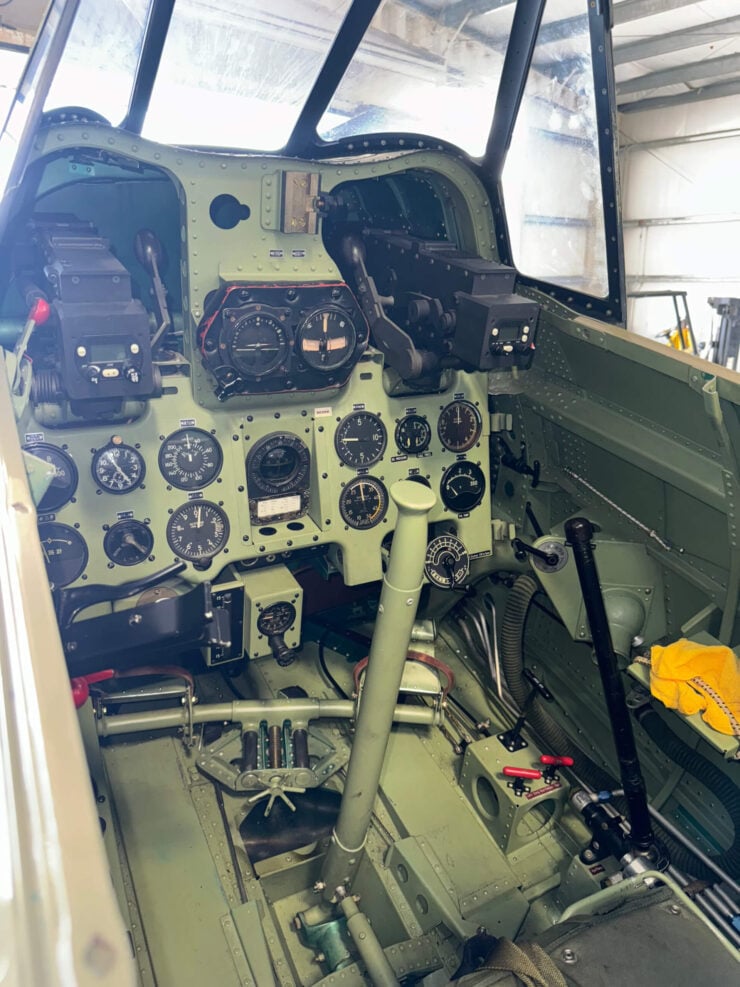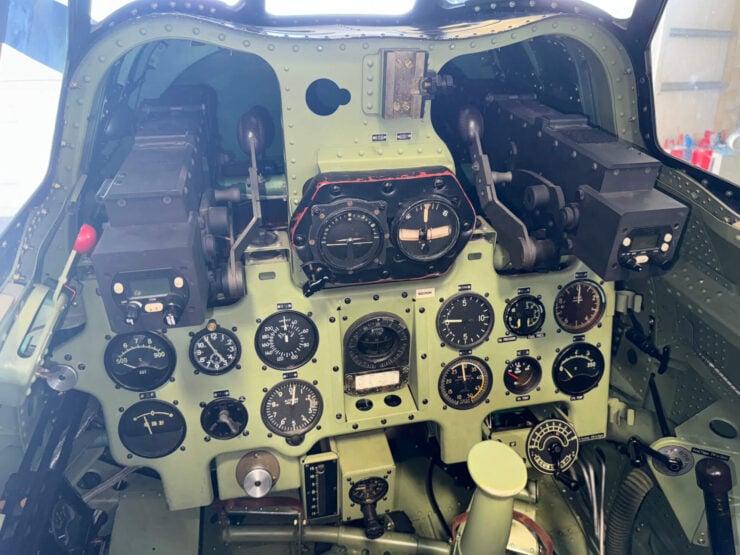This is a 1942 Nakajima A6M-2 Zero, a Japanese fighter aircraft from WWII that was shot down in the Pacific, crashing in the tropical jungles of the Solomon Islands.
The wreck was recovered in 1965 and the restoration began in 1994 by the Blayd Corporation of Canada. 60,000+ hours of labor later, and with 14,000 newly manufactured parts, the aircraft was once again able to take to the air. It’s now being offered for sale with an asking price of $5,000,000 USD.
Fast Facts – The Japanese Zero
- The Zero was developed by Jiro Horikoshi in the 1930s to meet the Imperial Japanese Navy’s need for a fast, lightweight carrier-based fighter. Lacking armor and self-sealing fuel tanks to keep the weight down, it became a dominant aircraft early in WWII despite its vulnerabilities.
- Powered by a Nakajima NK1C engine with up to 1,130 horsepower, the Zero excelled in early WWII dogfights. By 1943, however, Allied advancements began to surpass it. Over 10,000 Zeros were produced by both Mitsubishi and Nakajima, making it the war’s most mass-produced combat aircraft.
- The Zero’s lack of hydraulic boosting made it difficult to handle at high speeds, a weakness Allied pilots exploited. Its lightweight, fragile design also made it vulnerable in combat. By 1944, it was largely outclassed and increasingly used for kamikaze missions against Allied naval forces.
- This 1942 Nakajima A6M-2 Zero was recovered from the Solomon Islands in 1965 and underwent a 60,000-hour restoration. With over 14,000 new parts, it’s now airworthy and equipped with modern avionics. It’s being offered for sale for $5 million and remains a rare and valuable aircraft.
The Origins Of The Zero
The Mitsubishi A6M Zero was developed by Mitsubishi’s chief designer, Jiro Horikoshi, in the mid-1930s, first flying in 1937. The aircraft had been developed to meet the Imperial Japanese Navy’s “Planning Requirements for the Prototype 12-shi Carrier-based Fighter” requirements, which demanded a top speed of 270 knots (310 mph, 500 km/h) and the ability to climb to 3,000 meters (9,800 feet) in 9 minutes and thirty seconds.
Above Video: This video from Real Engineering goes into a deep dive on the development, operational use, and general history of the Zero.
These requirements had been sent to both the Nakajima Aircraft Company and to Mitsubishi Heavy Industries. After some initial work, the Nakajima team pulled out stating that the requirements were impossible to meet.
Over at Mitsubishi, Jiro Horikoshi, felt that his team could meet the stated goals, but only if the aircraft was made as light as possible – undertaking every weight saving measure possible and resulting in an aircraft with no protective armor, and without self-sealing fuel tanks.
As it played out, Horikoshi had been right, and his design would become widely regarded as one of the best carrier-based fighters of the Second World War.
Officially named the Mitsubishi Navy Type 0 carrier fighter ( 零式艦上戦闘機) the plane soon became known simply as the “Zero,” a reference to “0” being the final digit of the imperial Japanese year 2600 (1940 on our calendar) when it entered service with the Japanese Imperial Navy.
Though the Nakajima Aircraft Company had passed on the project they would still prove invaluable to it, providing the engine that would power the Zero. This engine was a Nakajima NK1C Sakae-12 air-cooled radial with two rows of 7-cylinders offset for 14-cylinders in total with a displacement of 27.9 liters (1,687 in³). Horsepower increased from 940 hp initially up to over 1,130 hp towards the end of the war.
A number of versions of the Zero were made, most were manufactured by Mitsubishi as the Mitsubishi A6M Zero, however the Nakajima Aircraft Company also built many of them under license. In total there would be 10,939 units made, making it the most prolifically produced combat aircraft of the entire war.
 There are very few airworthy Zeros in operation today, as a result they’re a very welcome guest at airshows and other aviation events.
There are very few airworthy Zeros in operation today, as a result they’re a very welcome guest at airshows and other aviation events.The Pros And Cons Of The Zero
The lightweight and excellent maneuverability of the Zero made it almost untouchable in dogfights in the early stages of the Pacific theatre of WWII. The Allies didn’t really have anything to match it until around 1943, though it did have some shortcomings.
The aircraft was relatively fragile due to its lack of armor, self-sealing fuel tanks, and ultra-lightweight design. It also didn’t have hydraulic boosting for its controls, meaning they became more difficult to operate at higher speeds – Allied fighter pilots realized they could potentially out maneuver the Zero in high-speed combat, and that the Zero’s rate of roll to the righthand side was slower than to the left due to the radial engine.
By 1944 and 1945 the Japanese were on the backfoot, the Zero hadn’t been given the same rate of accelerated development as the Allied fighters, and towards the end of the conflict the Zero was being used extensively for kamikaze missions – mostly against Allied ships in the Pacific.
Today, the Zero is rightly remembered as an engineering tour de force by the Japanese and as one of the best fighters of the war. It was a shock to the Allies just how good the aircraft was when they first started encountering it in the skies over the Pacific, and it helped spur them on to develop ever better aircraft of their own.
The 1942 Nakajima A6M-2 Zero Shown Here
The aircraft you see here is a Nakajima A6M-2 Zero built in 1942, when the aircraft still enjoyed relative superiority in the skies of Asia.
Above Video: This is an original WWII training film starring future President Ronald Reagan as a fighter pilot. It helps US servicemen to identify the Zero, and to differentiate it from the US fighters that were in use at the time.
As mentioned higher up, this Zero was recovered in 1965 in the jungle on the island of Ballale in the Solomon Islands. Somewhat confusingly, the historical record notes that this aircraft, tail code A1-1-129, was shot down over Russell Island, in the Solomon Islands, on the 4th of February, 1943.
Ballale and Russell Island are a few hundred miles apart in the Solomon Islands, so there may have been some historical miscommunication about the aircraft’s final location. Interestingly, the airfield that was built by prisoners of war for the Japanese during WWII still exists today.
During the 60,000 man-hour restoration it’s said that over 14,000 parts had to be manufactured. Mitsubishi Corporation in Japan assisted by providing original plans and blueprints, as well as Japanese engineering students to translate them into English.
The unfinished project was sold to a consortium led by Gerry Beck in the year 2000. At this time the instruments and hydraulics were fitted, as well an American-made Pratt & Whitney R-1830 radial engine for reliability and easier parts availability.
 The cockpit has been kept largely original, though some modern avionics and English-language labeling has been added for obvious reasons.
The cockpit has been kept largely original, though some modern avionics and English-language labeling has been added for obvious reasons.The aircraft is now in full flying condition, making it one of very few airworthy Zeros in the world and a very popular guest at airshows as a result. It’s now being offered for sale with 362.6 hours of use since the restoration.
It’s in largely original condition, though it does have some modern avionics and safety equipment installed for obvious reasons. If you’d like to read more about this Zero or enquire about buying it you can visit the listing on Platinum Fighter Sales here.
The lead image is of the same aircraft shown in this article, taken from the window of a DC-3 on a flight from the Reno Air Races to Wisconsin. The mountain in the background is Peavine Peak outside Reno, and near the Stead airfield where the Reno Air Races are held. The image was taken by the photographer Marc Grossman and is licensed under the Creative Commons Attribution-Share Alike 3.0 Unported license.
All other images courtesy of Platinum Fighter Sales

Articles that Ben has written have been covered on CNN, Popular Mechanics, Smithsonian Magazine, Road & Track Magazine, the official Pinterest blog, the official eBay Motors blog, BuzzFeed, Autoweek Magazine, Wired Magazine, Autoblog, Gear Patrol, Jalopnik, The Verge, and many more.
Silodrome was founded by Ben back in 2010, in the years since the site has grown to become a world leader in the alternative and vintage motoring sector, with well over a million monthly readers from around the world and many hundreds of thousands of followers on social media.




























